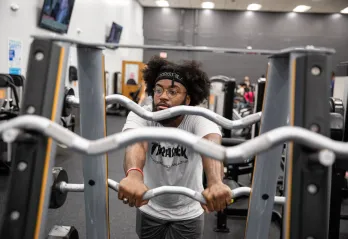The Importance of Resting Between Sets

When it comes to strength training, what you do between sets can be just as important as the exercises themselves. Whether you're new to the weight room or looking to enhance your current routine, understanding how long to rest can make a big difference in results.
Why Rest Matters
Rest intervals between sets aren't just about catching your breath. They serve several key purposes that directly impact your training outcomes:
- Reduced Injury Risk: Proper rest helps maintain form and technique, reducing the likelihood of injuries from fatigue.
- Energy Replenishment: Your muscles use adenosine triphosphate (ATP) for energy during lifting. Rest allows your body to refill these energy stores.
- Nervous System Recovery: Heavy lifting taxes your central nervous system, which needs time to recover between challenging sets.
- Optimal Performance: Complete recovery between sets allows you to maintain intensity throughout your workout, rather than seeing performance decline with each set.
Giving your body that time to recharge allows you to perform better and make progress safely.
How Long Should You Rest
Everyone has their own "why" when it comes to training. Maybe you want to feel stronger lifting your groceries, have more stamina when playing with your kids, or build that "toned" look you've been working toward. The amount of rest you take between sets can help you reach your fitness goals more effectively. Let’s break it down:
For Muscle Growth (Hypertrophy)
If building muscle is your goal, aim for 1–2 minutes of rest between sets. This moderate rest time gives your muscles enough time to recover without fully cooling down. That slight fatigue (metabolic stress) your muscles stay under will help trigger muscle growth (the kind that helps you build that "toned" look and stay strong in your day-to-day life).
For Maximum Strength & Power Gains
When your goal is pure strength and power (lifting heavier weights for fewer repetitions - aka powerlifting), your muscles and nervous system need more time to recover, so 3-5 minute rest periods are ideal. These longer rest periods allow you to maintain strength and power across multiple sets, while replenishing your ATP stores. Think of this as building the kind of strength needed to hoist a heavy stroller into the trunk or move furniture without strain.
For Muscular Endurance
If improving muscular endurance is your focus, you'll want to pair shorter rest periods of 30–60 seconds with higher reps and less weight. In this case, you're challenging your muscles' ability to perform under fatigue and training your cardiovascular system, so less rest time is ideal. This type of training helps your muscles work longer before getting tired, like holding your kiddo at the zoo or powering through yard work all day.
Make Your Rest Time Count
What you actually do during your rest time is also important. Don’t just pull out your phone and get lost scrolling through emails or social media. You’ll get distracted and will likely end up resting for too long, causing your body to cool down and reduce workout efficiency. Instead, use this time intentionally. Here are our favorite ways to fill the time:
- Focus on breathing: Calm your heart rate and refocus.
- Grab water: Hydration is key when it comes to energy and recovery.
- Mentally reset: Think about what felt good in your last set and what to adjust next.
- Try light mobility work: Gentle movement for non-working muscle groups can help you stay warm.
What about stretching?
It depends on your workout. Dynamic stretches or mobility drills are great between sets to maintain movement and circulation. But save static stretches (the kind where you hold a position) for your cooldown. They’re better suited for flexibility and recovery after your workout, not in the middle of it.
Listen to Your Body
While these guidelines provide an excellent starting point, individual recovery needs may vary based on:
- Age and overall recovery capacity
- Sleep quality and nutrition status
- Overall stress levels
- Training experience and conditioning
Pay attention to how your body responds. If you find your performance dropping off quickly between sets, try adding a bit more rest time. Over time, you’ll learn what works best for your body.
The Bottom Line
Rest isn’t wasted time. It’s one of the smartest training tools you have. Treat it as part of your workout, not a break from your workout. By tailoring your rest intervals to your specific goals and paying attention to how your body responds, you'll get more out of your workouts and see better results.
At the Y, we know that fitness isn't just about what you get done in the gym. It's about making everyday life feel a little easier and more enjoyable. Whether that means keeping up with your kids, tackling weekend projects without strain, or just feeling good in your body, smart training (and proper rest!) helps you get there.
We believe in empowering every member with the knowledge to succeed in their fitness journey. Need more guidance on optimizing your strength training routine? Our certified fitness professionals are always here to help you reach your goals. Together, we can build a stronger, healthier you!
Personal Training Explore Fitness Orientations Join the Y Today